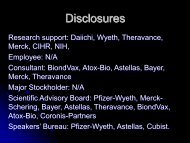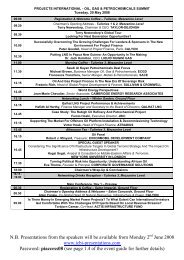Regulatory hurdles and opportunities
Regulatory hurdles and opportunities
Regulatory hurdles and opportunities
- No tags were found...
You also want an ePaper? Increase the reach of your titles
YUMPU automatically turns print PDFs into web optimized ePapers that Google loves.
<strong>Regulatory</strong> <strong>hurdles</strong> <strong>and</strong><strong>opportunities</strong>Professor Roger FinchNottingham University Hospitals &University of Nottingham, UKBSAC – The Urgent Need
Drug licensing <strong>and</strong> regulation• M<strong>and</strong>atory for market authorisation• Supports the public health <strong>and</strong> minimisesharm based on a risk:benefit assessment• Emphasis is on Quality, Efficacy <strong>and</strong> Safety• Provides guidance to industry• Agencies may also have responsibility forgranting marketing approval of diagnostics(eg MHRA, FDA)BSAC – The Urgent Need
Drug regulation <strong>and</strong> antibacterials– current concerns• Ever increasing bureaucracy• Time taken for evaluation/decisions often slow <strong>and</strong>therefore impacts on ROI• Changing regulatory processes• International harmonisation of requirementsremains a problem – drug development is global• Slow updating of published guidance• Ever increasing regulatory stringency at a timewhen the increase in untreatable infections hasbecome a risk in itselfBSAC – The Urgent Need
The regulatory: clinical needtension• Licensing cannot define the practice of medicine• Limitations in approved indications have resulted ina mismatch with clinical need• Drug resistant pathogens are responsible for manyinfections – impossible to study all indications• An indication only approach often frustrates widerapplication• Evidence that less stringent requirements will shiftrisk from industry to patients unprovenBSAC – The Urgent Need
Licensed indications of recentlymarketed antibacterialsDrug FDA approved IndicationsLinezolid 2000 CAP, cSSTI, HAP (including MRSA/MDRSP), VREErtapenem 2001 CAP, cSSTI (+ diabetic foot), cIAS, acute pelvic infectionsGemifloxacin 2003 Acute sinusitisDaptomycin 2003 cSSTI, Staph bacteraemia, right heart staph endocarditisTigecycline 2006 CAP, cSSTI, cIASDoripenem 2007 cIAS, cUTICeftobiprole 2009 cSSTI (diabetic foot)Telavancin 2009 cSSTI‘Helpful but –still a seriousmismatchbetween what isneeded <strong>and</strong> whatCAP = community acquired pneumoniac = complicated IAS = intraabdominal sepsisSSTI = skin <strong>and</strong> skin structure infections MRSA/MSSA is = methicillin licensed’ resistant/sensitive Staph aureusHAP = hospital acquired pneumonia MDRSP = multi-drug resistant Strep. pneumoniaeVRE= Vancomycin resistant enterococciUTI= urinary tract infectionBSAC – The Urgent Need
Streptococcus pneumoniae infections (USA)‘Can create similar‘pyramids’ for eachorganism includingdrug resistantpathogens’BSAC – The Urgent Need
Increasing stringency of trial• Non-inferiority• Placebo controlled• Superioritydesign• Changing delta: 20% to 7.5% according totrial design• Changes increasingly impact on drugs inphase III developmentBSAC – The Urgent Need
Generics <strong>and</strong> current attitudes toantibiotic use• Encourages the view that most commoninfections can be effectively managed withgenerics but this is not evidence based• Cost advantage of generics over propriety AIslargely based on superficial <strong>and</strong> impreciseeconomic assessments• Sustains a cost driven rather than healthoutcomes view of prescribing recommendationsBSAC – The Urgent Need
Drug Licensing <strong>and</strong> Regulation - Generics• No regulatory requirement to monitor resistance rates forgeneric AIs• No regulatory guidance on what are ‘acceptable’ resistance rates• Rates of resistance to many generics is high <strong>and</strong> above a levelthat would be acceptable for approving new agents• Indications remain unchanged despite resistance concerns <strong>and</strong>changes in prescribing practice• No additional safety requirements even for known toxicitiesroutinely requested for new agents eg QTc monitoring• Current policy of widening availability of medicines has createdthe risk of reclassification from POM to P in UK – ‘over thecounter use’BSAC – The Urgent Need
The BIG questions• Anti-infective medicines target infectingmicroorganisms• The clinical expression of disease varies bypathogen, site of infection, virulence <strong>and</strong> hostresponse• How robust is the external validity of approvedindications; concerns over international studies• Rarely do indications include particular targetpathogens• Can new models be developed to encourage,expedite <strong>and</strong> reduce the cost of AI developmentBSAC – The Urgent Needwithout compromising safety?
Future scenario• ‘Blockbuster’ antibacterial drugs are nowessentially historical• Targeted treatments are increasingly required• The focus should be on quality <strong>and</strong> not onquantity – novelty rather than ‘me-too’• More robust definitions of endpointsincluding duration of treatment are key togreater efficiency in drug development,clinical use <strong>and</strong> patient safetyBSAC – The Urgent Need
Future <strong>opportunities</strong> to expedite/exp<strong>and</strong>licensing of antibiotics• Orphan drug route for life-threatening infectionse.g. Pseudomonas VAP• Encourage accelerated approval for life-threateninginfections – primarily hospital treated conditions• Conditional approval where the expected benefit islikely to be large• Clarify position over ‘pathogen-specific’ indicationsversus diseases or syndromes• Exp<strong>and</strong> guidance on provisional licensing <strong>opportunities</strong>• Greater use of PK/PD to support clinical trials• Surrogate markers <strong>and</strong> the place of rapid diagnosticsBSAC – The Urgent Need
Exp<strong>and</strong>ing the role of PK/PD data• Essential in determining dosage regimens• Defines pathogen drug exposure profile• Predicts therapeutic effect• Defines dose to minimise resistance• Extend <strong>and</strong> review licensed dosage regimensto improve effectiveness eg levofloxacin• Define duration of therapy: currently up to 14days – evidence supports significantreductions are possibleBSAC – The Urgent Need
Exp<strong>and</strong>ing the role of PK/PD data• Greater integration of PK/PD studies in dossier:pre-clinical <strong>and</strong> phase I plus studies in smallerphase II/III trials leading to earlier ‘ConditionalApproval’• Phase IV studies to provide safety monitoring<strong>and</strong> continued evidence of efficacy leading to‘Full Approval’• Advantages – expedites development <strong>and</strong>licensing; reduces costs of phase III studies(currently $75-100K per patient); more focussedphase IV studies to increase safety dataBSAC – The Urgent Need
The phase III trial – other optionsfor change• Extrapolation of approval between indications that sharesimilar pathogens, pathophysiology <strong>and</strong> PK characteristicse.g. IAS <strong>and</strong> gynaecological sepsis; ABS <strong>and</strong> OM• Pooling of data recruited from prospective studies for‘difficult to investigate’ indications that share similarpathogens <strong>and</strong> antibiotic susceptibility profiles• Develop new continuous endpoints of response rather thanbinomial ‘cure/fail’ responses e.g. number/nature of ‘loosestools’; time to resolution of fever• Exp<strong>and</strong>ing the number of approved indications by makingst<strong>and</strong>ard the use of PK/PD data to reduce requirements to 1trial per major indicationBSAC – The Urgent Need
Provisional licensing• Drug development provides an essential but limitedprofile of therapeutic performance <strong>and</strong> safety in use• Greater emphasis on PMS studies could lead toearlier provisional licensing <strong>and</strong> even a ‘rollingprogramme’ of indications• Development programmes could start with non-lifethreatening <strong>and</strong> progress to life-threateninginfections which could provide more robustinformation on efficacy <strong>and</strong> safetyBSAC – The Urgent Need
RapidDiagnostics‘Taking theguessworkout ofprescribing’BSAC – The Urgent Need
The advantages of better <strong>and</strong> fasterdiagnostics• Supports clinical diagnosis• Confirms microbiological nature of infection• Supports appropriate selection of therapies• Distinguishes antibiotic responsive from nonresponsiveillness‘Goal – to use what wehave better, reduce the• Reduces risk of adverse risk drug of reactions resistance from <strong>and</strong>inappropriate therapy prolong the effectivelife of drugs’ AND• Reduces risks of antibiotic resistancealso support drug• Improves cost effectiveness of development prescribingBSAC – The Urgent Need
POC/Rapid diagnostics <strong>and</strong>drug developmentAdvantages• Adds precision to case definition• Potential ability to clarify microbiologicalend-points• Reduce unevaluable infections/patients• Reduce target numbers required for CT• Ability to enrich studies targeting drugresistant infections• Contain the costs of drug developmentBSAC – The Urgent Need
POC/Rapid diagnostics <strong>and</strong>drug developmentAdvantages• Adds precision to case definition• Potential ability to clarify microbiologicalend-points• Reduce unevaluable infections/patients• Reduce target numbers required for CT• Ability to enrich studies targeting drugresistant infections• Contain the costs of drug developmentBSAC – The Urgent Need
POC/Rapid diagnostics <strong>and</strong> drugDisadvantagesdevelopment• Novel diagnostics will need to be developed <strong>and</strong>independently validated• Pharma <strong>and</strong> Diagnostic companies are currentlymostly separate entities• Inclusion of a novel diagnostic may limit externalvalidity of findings in clinical practice in differenthealthcare settings thereby frustrating marketing• Current variability <strong>and</strong> often inadequate st<strong>and</strong>ards oflicensing <strong>and</strong> regulation of diagnostics will need to beBSAC – The Urgent Needaddressed
Economic assessments <strong>and</strong> pricing• Major international variation in process <strong>and</strong>requirements• Perception that antibiotics should be ‘cheap’• Comparisons with generic agents leads to apolicy of ‘reserving’ new agents• Contributes to low Net Present Value of AIs• Comparison with oncolytics – high NPV, highprice despite often limited lasting benefit –suggests different criteria are operatingBSAC – The Urgent Need
Recent controversyover price <strong>and</strong> NICEnon-approvalBSAC – The Urgent Need
<strong>Regulatory</strong> <strong>hurdles</strong> & Opportunities -Conclusions <strong>and</strong> recommendations• Safety must remain paramount• Process <strong>and</strong> guidance should be kept underconstant review• Make international harmonisation one of thehighest priorities• Be more proactive in expediting cost-efficientdrug development• Review <strong>and</strong> revise the licensed indications ofgenerics where these are now obsoleteBSAC – The Urgent Need
<strong>Regulatory</strong> obstacles & <strong>hurdles</strong> -Conclusions <strong>and</strong> recommendationsAddress the indications gap by:‣ Encouraging the use of surrogate markers, rapiddiagnostics <strong>and</strong> the orphan drug route‣ Continue to exp<strong>and</strong> the role of PK/PD in drugdevelopment‣ Encourage early conditional approval‣ Consider a rolling programme of approval forindications‣ Consider extrapolating approval for indicationswith similar microbiological, pharmacological &disease characteristicsBSAC – The Urgent Need








